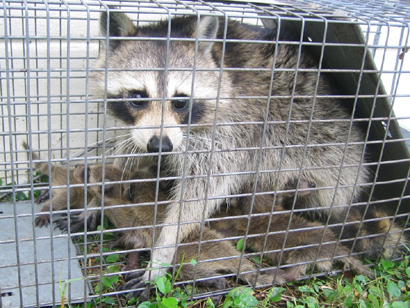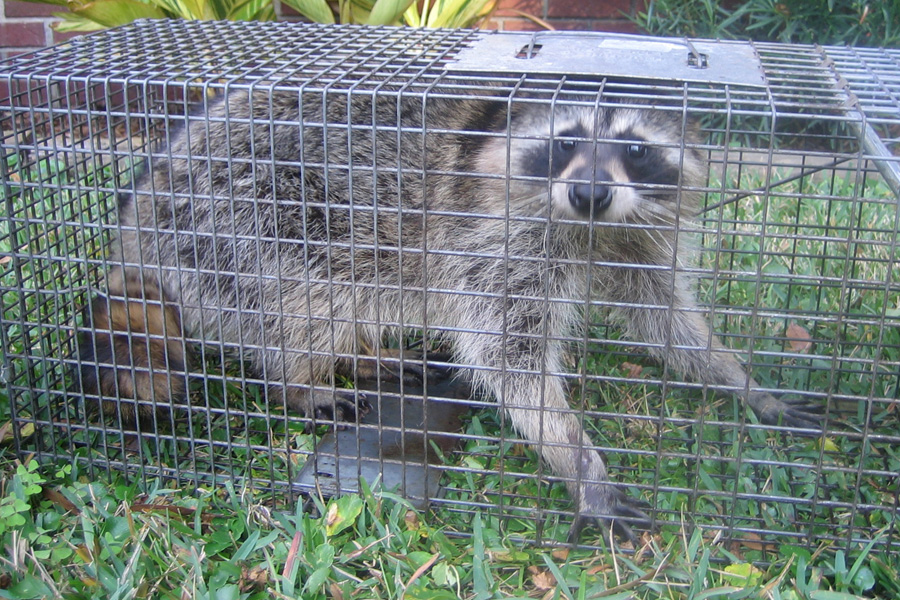- USA Wildlife Removal Education Guide and Resources
How to Trap a Raccoon

How To Trap Raccoons
Those who have never experienced a raccoon infestation will
imagine that these cute animals are simply a minor annoyance,
but the truth about raccoons is very different for those who
have come across the results of what raccoons can do. While
there are a variety of different options for those who are
dealing with a raccoon problem, trapping is a popular option as
it can remove the animals fairly quickly, and there are
different types of traps that can be used. Some people will
choose to hire a professional as raccoons can often be quite
elusive, but for those looking to do the work themselves, here
is a basic guide on how to trap these animals.
Using Cage Traps To Catch Raccoons
The most common method of dealing with a raccoon problem is to place cage traps in key locations near where the animals are active, and making sure that you have the right type of trap is very important. Choose a trap that is too small, and no raccoon will be tempted into the confined space, and if the trap is too large the weight of the raccoon may not trigger the trap, so look for traps designed for raccoons, feral cats or other similarly sized animals. The most common cage trap will have a door at one end of the trap, where the door closes once the trap is triggered and the raccoon is within the trap.
GET HELP: Do you need professional help with a raccoon problem? We have wildlife experts servicing almost every area of the USA! HIRE US IN YOUR TOWN
COSTS: You may want to read more about raccoons or the prices we charge for our services: READ ABOUT OUR RACCOON PRICES
Location And Bait For A Cage Trap
Choosing the right location for a cage trap is very important, and looking for areas of high traffic is a good spot, while you can also place the trap over an exit hole if the animal is nesting in an attic or loft space. If you are placing the trap outdoors, it is also worth looking for a spot under a hedge or natural cover, while placing a stone on top of the trap will also prevent it from being tipped over by the raccoon. Bait is often discussed, but is usually secondary to the location, but successful bait can often include marshmallows, wet cat food, fish and apple. Read more about raccoon bait.
Paw Grip Traps
This is another type of trap that is often used in rural areas, and essentially has a metal tube with a shutter that closes over the inquisitive raccoon's paws when it tries to reach the bait at the bottom of the tube. The tube itself is usually anchored with a chain, which is either attached to a rock, or best buried with a stake so that the raccoon isn't able to make a getaway while still stuck in the trap. The difficulty with this kind of trap is that it can be hard to remove the raccoon from the trap successfully if you are looking to relocate the animal, or it can become damage if you are planning on shooting the raccoon once it is trapped.
Snares
These traps tend to be used by old fashioned fur trappers, and those who have learned from them, as snares can be very difficult to use, and they are also likely to kill other animals if they aren't place correctly. This is a simple type of trap with a loop of cord placed so that it tightens around the animal's neck, which is then fixed to a fence post or stake. When this works correctly, it kills the raccoon quite quickly, but because of the risk of other animal casualties, this should be left to the experts.
Relocation Or Humane Euthanasia?
This choice will usually depend on your state's laws and regulations, as there are many areas where the relocation of raccoons is either illegal, or can only be carried out by licensed operators. This means that euthanasia is the only option, and your local animal department can offer guidance on whether they have recommended veterinarians or facilities within the state that can dispose of the raccoon for you. This is a particularly difficult choice as relocated animals do not have a great rate of survival, while euthanasia is not always a pleasant process for the animal either, and can be stressful for many creatures.
Dealing With A Raccoon Once It Is Trapped
Whether you are dealing with the carcass after using a lethal trap or the live animal, it is important to avoid any physical contact with the animal, so wear thick clothing and gardening gloves to protect from bites and scratches. If you are dealing with a live raccoon, throwing a thick blanket over the animal or the cage trap can make it much easier to transport the animal. If you do have to remove a carcass, make sure that you place it in a double layer of garbage bags, or in a sealed container, and that you dispose of it in line with the laws in your state.

Go back to the main Raccoon Removal page for more information about raccoon trapping and information about how to catch a raccoon in a cage trap.
Read more About Raccoons in my educational articles based off of my professional experience. Learn how to find and remove a Dead Raccoon and what kind of Damage raccoons can cause in the attic. Learn how to keep raccoons out of a chicken coop and how to get raccoons out of a chimney. Learn what to do with a raccoon after you catch it and if repellents will work against racoons in your chimney.
Learn if raccoon feces are dangerous to touch or breathe, and how to keep raccoons out of your bird feeder. Find out the best bait to trap a raccoon and how to know if there are Baby Raccoons in your Attic?. Read if you should feed a baby raccoon you found and my best advice for how to keep raccoons away from your property. Find out what attracts raccoons and what you should do if you find a nest of raccoons in the attic. I can also answer if raccoons ever attack people.

